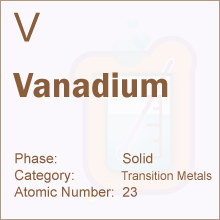 Periodic Table -> Vanadium
Periodic Table -> VanadiumVanadium
Vanadium DetailsVanadium Symbol: V
Vanadium Atomic Number: 23
Vanadium Atomic Weight: 50.9415
What is Vanadium?
Vanadium (atomic symbol V, atomic number is 23, atomic weight 50.9415) unlike other chemical elements named after their discoverers or famous scientists, Vanadium is actually named after a Scandinavian goddess called Vanadis.
Properties and Classification
Physically, the element is described as solid/hard silver-grey transition metal, with relatively good ductile and malleable properties. Vanadium's melting and boiling points are known to science - 1910 C and 3407 C respectively. Vanadium has a density of 6 grams per cubic centimetre. The element is classified as a metal, which is in solid state at room temperature.
Discovery and Rediscovery
Vanadium was first discovered by a Mexican chemist by the name of Andres Manuel Del Rio, in 1801. The chemist was probing into so called brown lead – a material which was still unknown at the time, and its physical and chemical properties were still unknown. Wanting to have his discovery confirmed and officialised, Del Rio sent a sample of the ore (brown lead) along with detailed notes to the Institute De France where the sample was to be analysed. A stroke of bad luck though sank the ship on which Del Rio’s notes were travelling to Paris, and in result Institute De France only received his ore samples with some brief notes on what they could be, and what they resembled in appearance and physical and chemical properties.

About thirty or so years later, in 1830, the chemical element was rediscovered by a Swedish chemist by the name of Niels Sefstrom. He stumbled on it whilst running tests on different types of ore in a Swedish mine. Although Sefstrom discovered the element in its natural environment, he could not isolate or synthesise it in any way. Actual isolation of Vanadium happened 35 years later in England, by the chemist Sir Henry Roscoe.
Isolation and Extraction Methods
Modern day chemistry has allowed for the relatively easy isolation of Vanadium from ore by heating the crushed raw material, whilst exposing it to certain chemicals. The natural mineral from which Vanadium is derived is called vanadinite.
Applications and Uses
Vanadium does have certain uses and applications, mainly because of its anticorrosive properties. Since the metal is corrosion resistant, it is used for the manufacturing of tubing and piping used in the chemical industry. As this metal doesn’t easily absorb neutrons, it also has certain applications in the atomic power industry. Vanadium is also used when bonding sheets of steel and titanium – a thin layer of Vanadium is applied to the other metals before bonding begins.
Vanadium is most widely used as a strengthening additive to steel and steel alloys. It makes steel more shock resistant meaning that it becomes physically stronger, as well as highly corrosion resistant. Motor vehicles from cars to trains and ships use Vanadium in the hardest working parts of their engines like axles, crank and drive shafts, gears, and so on.
You can
link to this page, using the code below:
Periodic Table |
Banks
© ElementsDatabase.com 2015 | Privacy | About | Contact